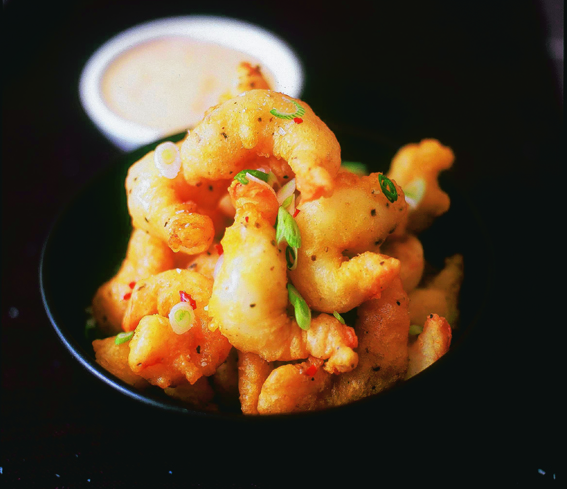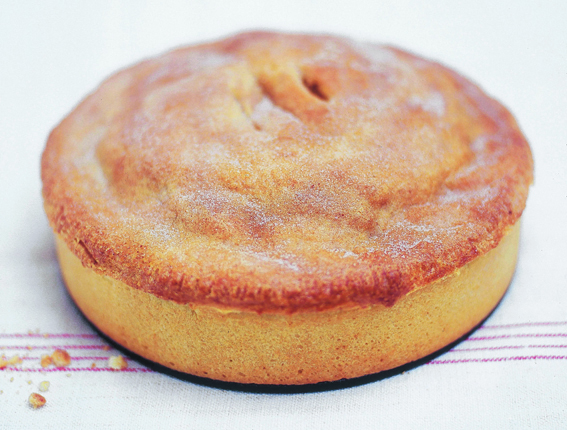Celebrity chef Marcus Wareing is back on our screens again, this time as a judge on MasterChef: The Professionals.
In a new edition of his best-selling book, How to Cook the Perfect… he reveals some of the skills that made him one of the country’s most respected chefs.
For each recipe he strips it back to the basics and identifies the key to perfection – the one element you need to get it right to guarantee success. Follow this and you too will be cooking like a professional.
Marcus said: “Tiger prawns and soft-shell crabs are my favourite starters when I go out for a Chinese meal, and it’s hard to choose between them. These prawns in tempura batter are easy to make at home – and they’re great to serve as canapés with drinks.”
As for the pud he said: “I always make apple pie this way, with two different types of apples. I use tart cooking apples that break down to make a firm compote base, and sweet eating apples that retain their shape so the slices sit pretty on top. With its crisp, buttery pastry, it’s sheer perfection.”
SALT AND PEPPER PRAWNS
SERVES 4
16 raw tiger prawns in their shells
85g plain white flour
Vegetable oil, for deep-frying
Sea salt and finely cracked black pepper
FOR THE TEMPURA BATTER
50g plain white flour
50g cornflour
1/4tsp bicarbonate of soda
150ml ice-cold sparkling water
2 ice cubes
1 large organic egg white, lightly whisked until frothy
TO SERVE
2tsp Thai sweet chilli sauce, or to taste
4tbsp good-quality mayonnaise
1 red chilli, deseeded and finely chopped
2 spring onions, finely chopped
First make a dip to serve with the prawns by mixing the chilli sauce into the mayonnaise. Keep in a covered bowl in the fridge. Peel the prawns and cut in half lengthways. Remove any black veins, then rinse briefly under the cold tap. Don’t worry if the prawns are wet – this will help the flour stick.
Spread the flour out on a tray, sprinkle with a little salt and plenty of pepper, and stir well to mix. Toss the prawns in the seasoned flour until evenly coated, then shake off the excess. Make the tempura batter by sifting the flour, cornflour, and bicarbonate of soda into a bowl. Add the water, ice, and egg white, and whisk gently just to mix. Season with a little salt.
Heat oil in a wok or deep-fat fryer to 170C. To test the oil without a thermometer, dip a prawn in the batter and drop into the hot oil – if the batter crisps up within 2–3 minutes, the oil is hot enough. Drop about one-third of the prawns into the batter and stir gently to coat, then take them out with a slotted spoon and lower them one at a time into the hot oil. Deep-fry for 2–3 minutes until the batter becomes crisp and light golden. Lift out with a slotted spoon and drain on kitchen paper while frying the remaining prawns in two batches.
Serve sprinkled with sea salt, chopped chilli, and spring onions, with the bowl of chilli mayo on the side.
TOP TIP: Don’t try to deep-fry all the prawns at once. This will lower the temperature of the oil and the batter will not crisp up.”
KEY TO PERFECTION: Sparkling water and bicarbonate of soda make tempura batter as light as air. The secret is to work fast and not overmix, or you’ll knock out the sparkle. Add the water and ice cubes to the dry ingredients and immediately start whisking. You need to mix everything together as quickly as possible. Whisk just until the ingredients come together. Don’t try to whisk the lumps out – they will disappear when the batter is cooked.
DEEP DISH APPLE PIE
SERVES 10
1 quantity chilled Sweet Shortcrust Pastry (see below)
100g caster sugar mixed with 20g ground cinnamon
1 large organic egg white, lightly beaten
FOR THE FILLING
6 large Bramley apples (about 1.5kg total weight)
30g unsalted butter, diced
2–3 cinnamon sticks, broken into large pieces
150g caster sugar
5 medium Braeburn or Pink Lady apples
FOR THE PASTRY
230g plain white flour, sifted with a pinch of fine salt
150g chilled unsalted butter, diced
75g caster sugar
Finely grated zest of 1 lemon
1 medium organic egg, beaten with 1 medium organic egg yolk
TO MAKE THE PASTRY
In a large bowl, gently work the flour and butter together until the mix looks like breadcrumbs. Stir in the sugar and lemon zest, then add the eggs slowly to form a dough. Gently shape it into a ball and flatten slightly, then wrap tightly in cling film and refrigerate for 2 hours before using. This pastry is very fragile, and handles best when well chilled, but the end result is well worth the care and time taken.
Peel, quarter, and core the Bramley apples, then chop into small pieces. Warm a large, heavy pan over a medium heat. Add the butter and wait until it starts to foam, then add the cinnamon sticks and sauté for 2–3 minutes to get the spicy aroma going.
Add the apple pieces and the sugar, and cook uncovered for about 20 minutes until fairly dry, stirring occasionally. Tip the apple compote out of the pan and spread over a large platter or tray. Leave until cold.
Meanwhile, roll out two-thirds of the pastry on a well-floured surface to 5mm thick. Use to line a loose-bottomed 20 x 5cm cake tin or springform tin, patching any cracks and letting the pastry hang over the top. Set the tin on a baking tray.
Roll out the remaining pastry to make a lid 3mm thick and place between two sheets of floured greaseproof paper. Refrigerate the pastry case and lid for 1 hour.
Spread the cold compote in the chilled pastry case, discarding the cinnamon. Peel the Braeburn apples, halve them lengthways, and cut out the cores. Slice the apples 3mm thick.
Arrange the apple slices overlapping on top of the compote, spiralling them in from the edge and doming them in the centre. Sprinkle them with some of the cinnamon sugar as you are layering them up.
Brush the edge of the pastry case with egg white. Place the chilled pastry lid carefully on top and press to seal the edges together. Trim and fork around the edge, and cut two or three slits in the centre of the lid. Refrigerate for 1 hour.
Heat the oven to 180°C fan (200°C/gas 6). Brush the pie lid with egg white and sprinkle with some of the remaining cinnamon sugar, then bake on the tray for 55–60 minutes, covering the top with foil if it becomes too brown.
Leave the pie to rest for about half an hour before removing it from the tin. Sprinkle with more cinnamon sugar before serving.
TOP TIP: To turn this pie into a tart, make the pastry case slightly thicker and leave the lid off. The tart will cook in about two-thirds of the time.
KEY TO PERFECTION: The Bramley apple compote needs to be quite dry. If it is wet, it will seep into the pastry base and make the pie soggy. Start cooking the Bramley apple pieces over a medium heat with the butter, cinnamon, and sugar – they will soon break down to a pulp. Just before the end of the cooking time, increase the heat to high and stir vigorously – this will drive off the moisture and help the compote become thick and dry.


